My Writing Practice and a Place for me to Promote Friendly Blogs
Don't wanna be here? Send us removal request.
Text
This is how my players plan to deal with assassins
“Pump up that CHA, oil up those pecs, rip off that loincloth and get jiggy with em.”
988 notes
·
View notes
Photo










Everyone Say hello to the Hollower! This Class was a commission I did for @arcane-ethereality, based on some early musings about an umbramancer or shadow-magic fighter. The Idea evolved a lot from it’s original roots, and is heavily based on the idea of great power at great cost. Be wary, as this class is still experimental. It is designed to balance using levels of debilitating madness rather than through the traditional mechanical limits. It has potential to be vastly overpowered, or dangerously unplayable as those madness effects stack. If you are Interested in Play-testing the Hollower, shoot me a Message with the following Info, and I’ll send you the PDF: Player or DM? How long have you been Playing? Are you using the Class as a PC or NPC? What Level will you be starting at? When will you Start Playing? How long do you expect to be playing?
5K notes
·
View notes
Photo

A bunch of you have seemed interested in player character stats for the bug people so here’s my take on the bees for 5E!
Formatting courtesy of The Homebrewery
744 notes
·
View notes
Text
Rations for various RPG Races
[[ Source. Original creator: wats6831. Additional information and images linked under each one. Love this project? Support it here! ]]
Universal:
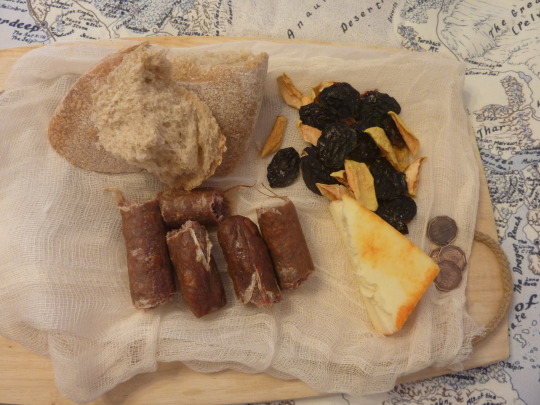
Homemade artisan herb bread, home grown and dried apples and prunes, uncured beef sausage, munster cheese. Made a small bag from cheesecloth and tied it closed.
Discussion thread here.
Human:

Waterdhavian oat loaf (handmade irish soda bread, fresh smoked ham shank, “dessert” pear, Corm Orp “mountain” bleu cheese served on butternut squash, imported Saerloon broccoflower (Romanesco), mixed garden vegetables (carrots and radishes), Misty Forest chestnuts.
More images here. Discussion thread here.
Dwarf:

Garlic chicken livers, smoked and peppered cheese, spiced pork sausages, hard tack, dried vegetables, dried wild mushrooms.
Discussion thread here.
Elf:

Top left to right: Evereskan Honey Comb, Elven Travel Bread (Amaretto Liquer Cake with custom swirls), Lurien Spring Cheese (goat cheese with garlic, salt, spices and shallots), Delimbyr Vale Smoked Silverfin (Salmon), Honey Spiced Lichen (Kale Chips), and Silverwood Pine Nuts.
Discussion thread here.
Halfling:
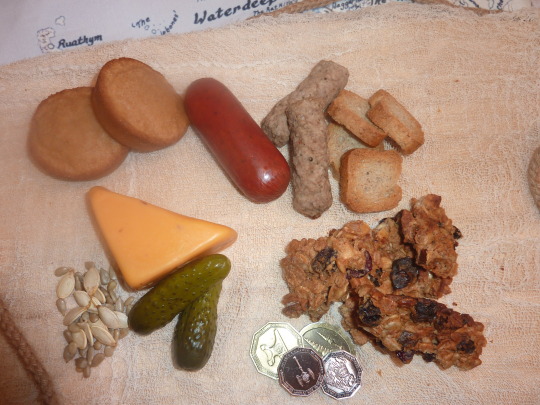
From upper left: “Honeytack” Hard tack honey cakes, beef sausage, pork sausage mini links, mini whole wheat toast, cranberry cheddar cheese mini wedge, mini pickles, pumpkin and sunflower seeds, lower right is my homemade “travel cake” muesli with raisins, golden prunes, honey, eggs and cream.
Discussion thread here.
Half-Orc:

Wrapped in cheesecloth and tied in burlap package. Forest strider drumsticks, molasses sweet wheat bread “black strap”, aged Munster, hard boiled eggs, mixed wild nuts.
Discussion thread here.
Orc:
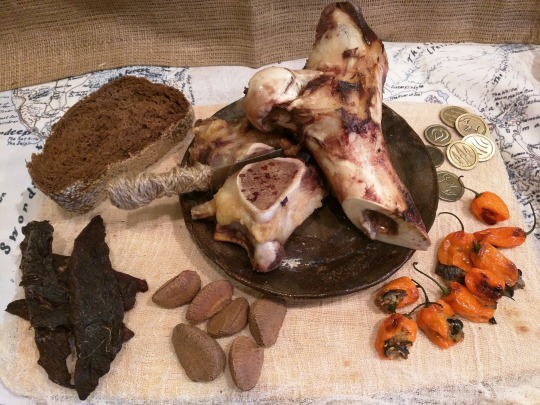
Orcs aren’t known for their great cuisine. Orcs prefer foods that are readily available (whatever can be had by raiding), and portable with little preparation, though they have a few racial delicacies. Toughs strips of lean meat, bones scavenged from recent kills, and dark coarse bread make up the bulk of common orc rations.Fire roasted rothe femur (marrow is a rare treat) [beef femur], Strips of dried meat (of unknown origin) [homemade goose jerky], foraged nuts, only edible by orcs….nut cracker tusks [brazil nuts], coarse black bread, made with whatever grains can be pillaged [black sesame bread], Pungent peppers [Habanero peppers stuffed with smoked fish and olives].
More images here. Discussion thread here.
Gnome:
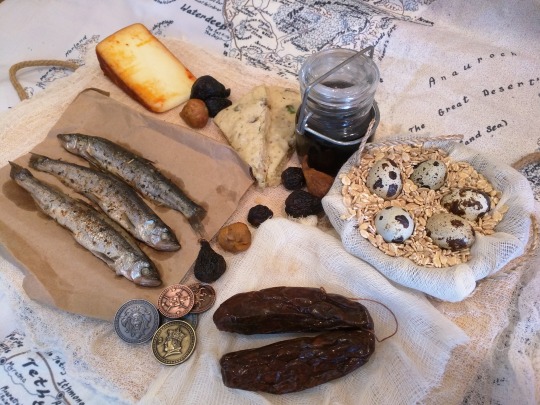
Pan fried Delimbyr smelt, spiced goat cheese (paprika crusted hand pressed Fontina), Gnome shortbread (savory pistachio), glass travel jar filled with Secomber Red (wine), hard boiled quail eggs packed in rolled oats (to keep safe), dried figs from Calimshan, and Southwood smoked goat sausage (blood sausage).
More images here. Discussion thread here.
Duergar (gray dwarves):
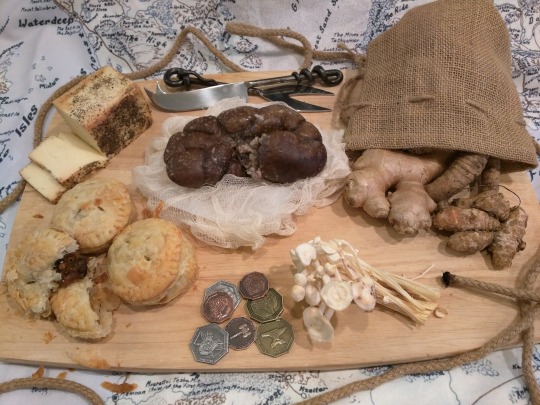
The Duergar (gray dwarves) are the hated subterranean cousins of the surface dwelling Shield dwarves. Vast Duergar kingdoms exist in the Underdark beneath Toril’s surface. Duergar are known for their foul tempers, penchant for cruelty, grim and bitter dispositions. Their food is as coarse and uncouth as they are. Clockwise from top left: Sour Deep rothé pepper cheese (Limburger), boiled Deep rothé kidney (whole beef kidney), foraged roots and tubers; skirret and Fellroot (ginger and turmeric roots), contorted strangler fungus (Enoki mushrooms), onion & mushroom gravy hand pies (Morel mushroom with shallot and dill in cream sauce).
More images here. Discussion thread here.
Lizardfolk (This is a MEAL/feast and not a travel ration):
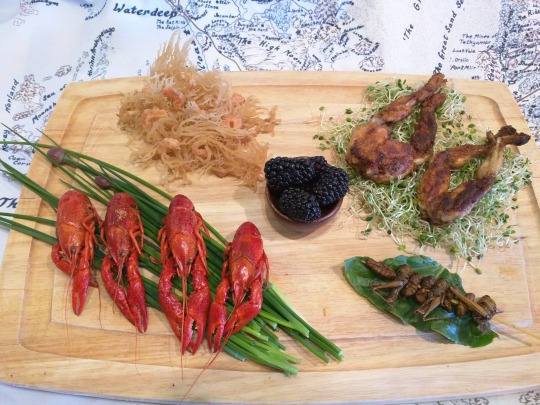
Lizardfolk are known to be omnivores, forage for a surprising variety of foods found within the confines of their marshy environs, in this case the Lizard Marsh near Daggerford. Fresh caught boiled Delimbyr Crayfish on wild chives, coastal carrageen moss entrapping estuary brine shrimp (irish moss, dried brine shrimp), Brackish-Berries (blackberries), Blackened Dart-Frog legs (frog legs) on spring sprouts (clover sprouts), roasted bog bugs on a stick!
More images here. Discussion thread here.
Drow (This is a MEAL/Party Fare and not a travel ration):

From top left: Menzoberranzan black truffle rothe cheese (Black Knight Tilsit), Donigarten Moss Snails (Escargot in shallot butter sauce), Blind cave fish caviar in mushroom caps (Lumpfish caviar), faerzress-infused duck egg imported from the surface Realms (Century egg), Black velvet ear fungus (Auricularia Black Fungus Mushroom).
More images here. Discussion thread here.
221K notes
·
View notes
Text
Dungeon Crafting: Puzzle Dungeons

image source: Legend of Zelda: Oracle of Ages
Now, I don’t know if you people have seen Mark Brown’s miniseries on YouTube known as Boss Keys, but it’s pretty great. It picks apart and analyzes some of my favorite dungeons from the Legend of Zelda games and finds out what makes a dungeon a Zelda dungeon. I have always loved these dungeons because they have a lot of density and force you to explore the space slowly and think your way through its puzzles. Definitely check out Boss Keys. From what I learned from those videos plus my own experiences as a DM, I’m going to try and detail how to create a Zelda-like puzzle dungeon. There are a few hallmarks that you should hit on:
Dungeon Density
Each area in the dungeon should be complex. It should have several things to interact with in each room other than the monsters or guardians. Everything doesn’t have to be immediately useful or usable, but it should provide context for the dungeon. For ideas, think what the dungeon was used for and research what sorts of things might be in an ancient tomb, lost temple, or forgotten keep. Have certain puzzle elements stand out. A good example from the Legend of Zelda is the eyeball above a closed door. I would stray away from that type of “puzzle” as it’s very well-known, I assume, that you have to hit the eye to open the door. On the other hand, a well-known puzzle like that could signal to the players that this is going to be one of “those” dungeons.
Making a dungeon complex and dense will mean that you have less rooms to populate, and will make it feel robust and well-used. It will also give a feeling of slight confusion for the players as they try to organize all of the information you’re giving them, but as the dungeon progresses, they can pick and choose which parts of the dense dungeon are integral to solving the dungeon!
Hub Areas
With all of that dungeon density I’ve been talking about, it’s good to have some sort of hub area. It could be a large room, a safe sanctuary, or have some overbearing landmark for players to imprint on. This will be the main part of the dungeon that they remember and can rely on. They will pay the most attention to this hub. So if this hub is a main part of solving your dungeon puzzle, they will notice changes made to the room very easily. For instance, a hub room could be a gaping chasm with bridges that seem to be mechanical. When certain levers in other parts of the dungeon are pulled, some pathways in the hub open up and some close off as the bridges ascend, descend, or turn. Back in my post about dungeon tempo, this creates a nice rhythm for players to always come back to a room that they’ve cleared and notice progress.
Branching Paths
Branching paths are a key part of puzzle dungeons. Don’t have a dungeon that is all one path that railroads players to the end of the dungeon with a puzzle for each room. Players need to be able to explore and discover the available paths in the dungeon and find the path for themselves. In the Boss Keys miniseries I mentioned, Mark constantly differs Legend of Zelda dungeons by whether they make you find a path versus making you follow a path. I personally enjoy finding the path and I think most players do too. It is key in creating what are known as…
A-Ha Moments
An a-ha moment is not that feeling you get when listening to Take On Me, but it’s pretty close. It’s that feeling a player gets when they figure out a puzzle by suddenly putting two and two together. There are a few aspects to create this in dungeon and level design:
Foreshadowing: implying that one part of the dungeon must be revisited later or implying something further in the dungeon exists. Laying this groundwork puts thoughts in players’ heads to help them markedly acknowledge that it’s okay to leave this area, because something lies ahead.
State Changes: the environment of the dungeon or its parts changes based on the actions of the players. This is the “puzzle” part of the a-ha moment. Pressing a button to change gravity, move a pylon, or change water levels can would count as a state change. Even acquiring a key item that can affect the dungeon or the players’ movement would count (see Link’s Pegasus Boots, Hover Boots, Silver Gauntlets, etc.)
Backtracking: After the state change, the dungeon has shifted. Some areas that were once inaccessible can now be accessed, and areas that were once open have closed off. This forces the players to backtrack. Where do they backtrack to? The place that foreshadowed the backtracking.
How does this look in practice? Let’s make an example:
The players enter a dungeon and quickly make it to a hub area with four doors. three of the doors have a bridge extending from it to a central platform. The platform and bridges are 100 ft. above a pit of spikes, which are very satisfying to kick the kobolds in this room onto. Once players tire themselves of punting kobolds, they notice that the central platform has a large plinth with a stationary mirror set into it. The mirror is facing one of the directions of the bridges. The mirror can’t be easily moved without tools, and it has no apparent use yet. The players move on to one of the doors connected by the bridge.
The players go through several chambers, fighting monsters and avoiding traps, when they find a room with a lever in it. When pulled, they hear a low rumbling and grinding of stone elsewhere in the dungeon. When they return to the hub room, the central platform and bridges have rotated, allowing passage to the door that didn’t have a bridge leading to it before.
Down this new route, the players find a stone button with an angel relief on it. After pushing a huge rock onto it, they hear another rumbling. On returning to the hub room, an angel relief is now visible on the wall as a stone slab has moved away to reveal it.
The yet unexplored room is still accessible by the bridge, and after exploring down that path, the players find a crank near a gilded relief of a sun. The crank opens up a sunroof in the hub area. The sun (if daytime) shines light onto the central mirror in that room, which then reflects it out in one direction. The only problem is, the beam of light from the mirror isn’t facing the way the PCs want (towards the revealed angel relief in the hub area).
Realizing that they need to point the mirror so the light shines on the angel relief, they must backtrack to the room with the lever that rotates the bridges and mirror until the mirror is oriented the way they want.
This example has density. It’s essentially four rooms with all the things they need to solve a puzzle in the hub area (the central room with the bridges). It could use more density though with more puzzle intertwined throughout some filler rooms or with more things to do in each room; I was light on description for the purpose of the example. It has three branching paths (four if you include where they entered from). The mirror foreshadows a light puzzle, and the sun icon foreshadows the opening of the sunroof. The bridges, angel relief, and sunroof all exist in the hub area and change states based on the players’ actions in the rest of the dungeon. Players have to backtrack to the room that changes the bridge orientation so they can rotate the mirror to face the right direction. This is a fairly simple puzzle, but in the context of a session of D&D where the story less shown and more told, it can prove more difficult. Keep all of these factors in mind when making a puzzle dungeon, and don’t forget to watch Boss Keys!
3K notes
·
View notes
Text
D&D Dungeon Design: Flow, Rhythm, and Pacing
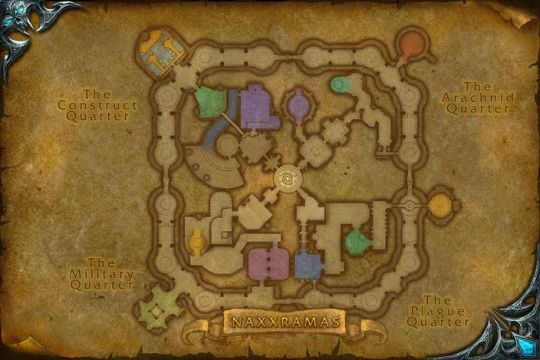
image source: World of Warcraft instance map of the Naxxramas dungeon
My last post talked about the concepts of contrast relating to dungeon design. Here I want to explore how sequencing of contrast builds anticipation and then later resolves that anticipation. It’s basically a study in how to create drama in your dungeon. Let’s define a few things first:
Flow: The emotional movement of dungeon encounters/spaces in sequence.
Rhythm: Variation or lack thereof in the sequencing of dungeon encounters/spaces.
Pacing: The changes in tempo/emotion of the rhythm and flow of a dungeon.
When I say dungeon encounters/spaces, I mean that these can refer to encounter difficulty, encounter type, room design, monster types, or anything else in your dungeon that can be put into sequence. Use rhythm, flow, and pacing as abstract concepts when planning out all parts of your dungeon. Now let’s see how these can be used:
Keep reading
867 notes
·
View notes
Photo
When that friend is also your GM, fucking respect when he asks you about character details. That's all the time you are going to get to work it out in the GMs world

21K notes
·
View notes
Text
The wizard got excited when we were told to recover a magic artifact

1K notes
·
View notes
Photo
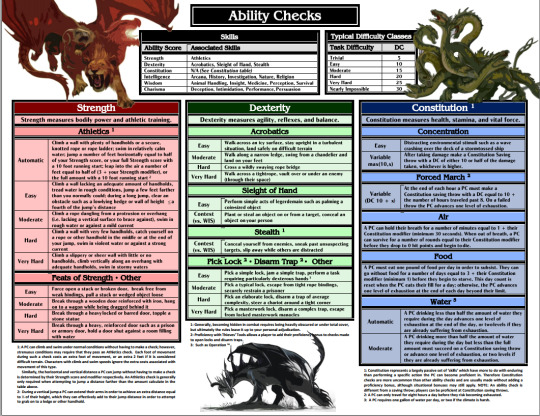
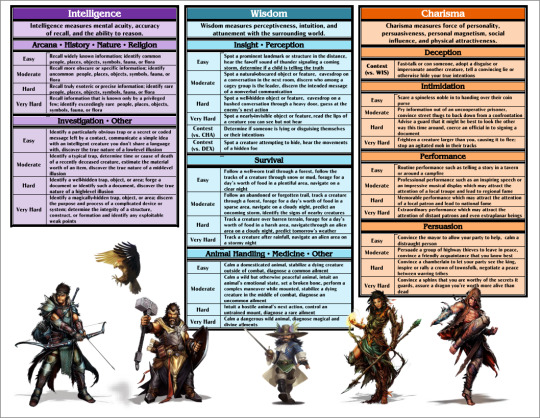
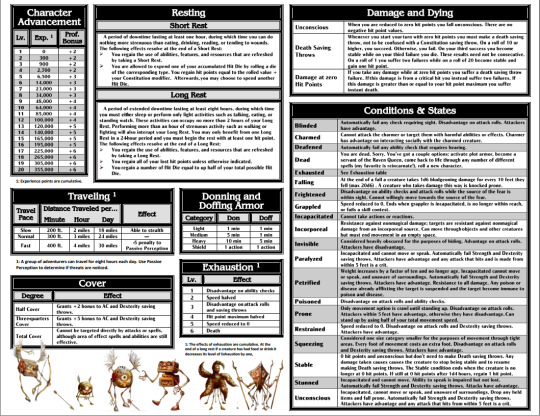
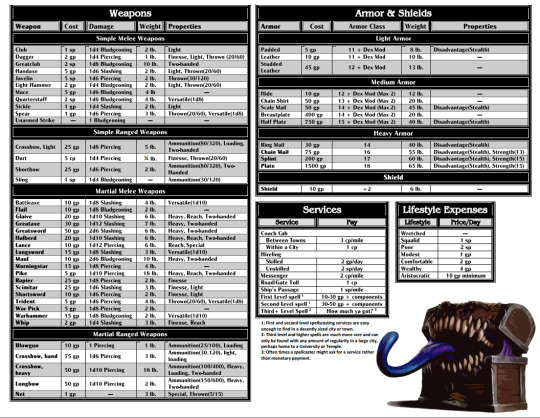
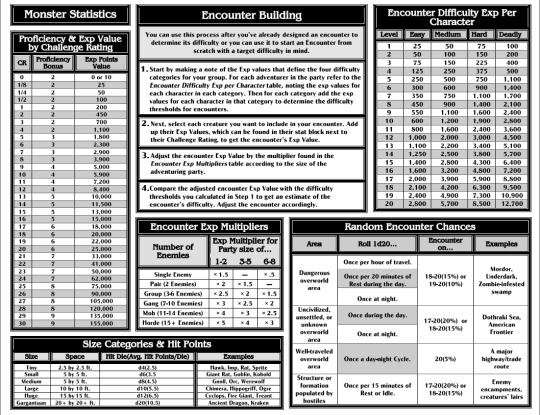
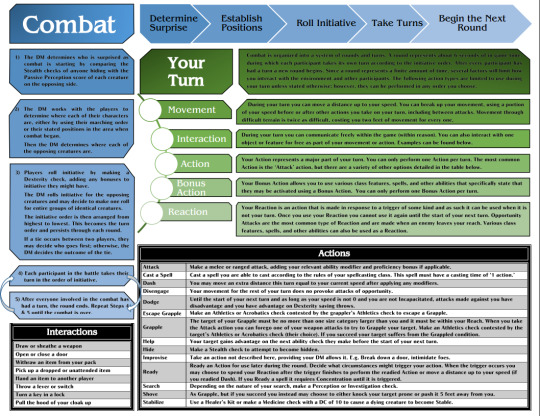
To the person who put this together, BLESS YOU
41K notes
·
View notes
Photo

ROLL YOUR CLASS
Roll 1d100, adventurers. (It’s entirely possible to end up with “adventurer”).
84K notes
·
View notes
















